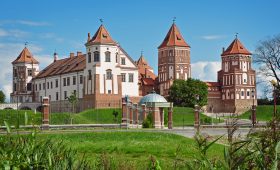Tibesti Mountains in Chad
Exploring the Tibesti Mountains
Located in northern Chad, the Tibesti Mountains rise dramatically from the Sahara Desert. This region is known for its rugged beauty and challenging terrain. The mountains are remote and largely untouched by tourism, offering a unique experience for those willing to venture into this isolated area.
Geographical Features
The Tibesti Mountains are characterized by volcanic peaks, deep canyons, and hot springs. Emi Koussi, the highest peak, stands at 3,415 meters (11,204 feet) and offers stunning views of the surrounding desert. The area is also home to numerous geological formations, including ancient lava flows and palm-dotted oases.
Flora and Fauna
Despite the harsh climate, the Tibesti Mountains support a surprising diversity of life. The region’s flora includes hardy shrubs, succulents, and desert roses, thriving in the valleys and slopes. These areas also provide habitats for various bird species, such as the Egyptian vulture and Nubian bustard. Wildlife includes Barbary sheep, gazelles, and the elusive Saharan cheetah.
Visiting the Tibesti Mountains
Traveling to the Tibesti Mountains requires careful planning due to the region’s political instability. As of 2023, the area is considered unsafe for tourists due to the presence of drug traffickers, mercenaries, and ongoing conflicts. If you decide to visit, it’s crucial to stay informed about the current situation and consider the risks involved.
Best Time to Visit
If conditions allow, the best time to visit is during the cooler months from November to February. Daytime temperatures range from 10°C to 25°C (50°F to 77°F), while nights can drop to around 0°C (32°F). The dry season offers clearer skies and better visibility, but always check for travel advisories before planning your trip.
Getting There
Accessing the Tibesti Mountains is challenging. The journey typically starts in Chad’s capital, N’Djamena, with a domestic flight to Faya-Largeau. From there, hiring a local guide and a 4×4 vehicle is essential. The roads are rough, and having an experienced guide is crucial for navigating the terrain safely.
Local Transportation
Within the mountains, transportation is limited. Most exploration is done on foot or by camel. Hiring a local guide is advisable to navigate the area and gain insights into the region’s history and culture.
Safety Considerations
The Tibesti Mountains are a high-risk travel destination. Kidnappings and minefields are concerns, and the political situation is volatile. If you choose to visit, do thorough research, stay updated on current events, and prioritize your safety. Consider waiting for a period of relative stability before planning your trip.
Summary of Facts
- The Tibesti Mountains are in northern Chad.
- The region is remote and largely untouched by tourism.
- Features include volcanic peaks, hot springs, and unique geological formations.
- The area supports diverse flora and fauna adapted to harsh conditions.
- Travel is challenging and requires careful planning due to safety concerns.
- Access is typically through Faya-Largeau, with local guides essential for exploration.





Hello,
I’m looking to explore Northern Chad, particularly Tibesti and the Ennedi plateau. Is this even possible right now?
Thanks in advance. Norm